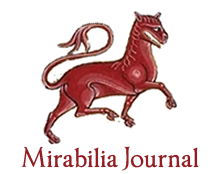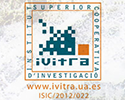Nicholas of Cusa in dialogue with his sources: the redefinition of Platonism
Claudia D’AMICO
Original title: Nicolás de Cusa en diálogo con sus fuentes: la re-definición del platonismo
Published in Nicholas of Cusa in Dialogue
Keywords: Medieval Platonism, Nicholas of Cusa, Sources.
This paper presents the Cusanus’s thought given its knowledge of the Platonic tradition considering its Christian version –Dionysius, Scotus Eriugena, the Chartrenses, Meister Eckhart, Bertold of Moosburg – as some authors Athenian Neoplatonism, especially Proclus. The text is divided into three points (I) the presence of this tradition in early works; (II) the defense of these sources in the Apologia doctae ignorantiae; (III) the reinterpretation of tradition from new receiving texts from 1450.
Nicolau Primitiu and the Interest on the Cultural Legacy of the Kingdom of Valencia
Alaitz ZALBIDEA BERENGUER
Original title: Nicolau Primitiu i l’interés pel llegat cultural del Regne de València
Published in
Keywords: 20th c., Nacionalism, National renaissance, Nicolau Primitiu, Valencia.
This article is devoted to the analysis of Nicolau Primitiu-Gómez-Serrano’s works (1878-1971) devoted to reivindicate the dignity of Valencian culture, such as essays, personal memories), and poems. The article offers an overview of his thought based on the analysis of his works devoted to medieval culture. Quotes from his works allow the reader to get a taste of the author’s genuine Valencian, full of medieval nuances both in its morphology and vocabulary.
Nobility and Diplomacy in Portugal (15th century)
Douglas Mota Xavier de LIMA
Original title: Nobreza e diplomacia em Portugal (séc. XV)
Published in Society and Culture in Portugal
Keywords: Diplomacy, Nobility, Portugal.
From the studies of the new history of medieval diplomacy, the article addresses the participation of the nobility in diplomacy, considering the kingdom of Portugal in the fifteenth century, when the office of ambassador gained its first definitions in the West. The text discusses the role of the courtesan nobility, focusing attention on the Sousa and Silveira families, lineages with important presence in diplomacy.
Nosce teipsum in Ramon Llull’s work
Jaume MEDINA
Original title: Nosce teipsum en l’obra de Ramon Llull
Published in Ramon Llull. Seventh centenary
Keywords: Anthropology, Catalan Literature, Ethics, Medieval Philosophy, Middel Ages, Ramon Llull, Theology.
Even though the presence of the Delphic precept «γνῶθι σαυτόν» («nosce teipsum») in Ramon Llull’s work is scarce, the research done in the present study reaches a twofold conclusion: firstly, the master's knowledge of the precept; secondly, the importance he gave to it in some central passages of his production.
O símbolo contra o texto: Pseudo-Dionísio Areopagita e a irrepresentabilidade divina
Henrique Marques Samyn
Published in The Philosophical Tradition in the Ancient and Medieval World
Keywords: Allegory, Pseudo-Dionysius the Areopagite, symbol.
Oh Fortune! Reminiscence of the Boecian Consolatio in the moral verses of Carmina Burana
Mariano OLIVERA
Original title: ¡Oh Fortuna! Reminiscencia de la Consolatio boeciana en los versos morales de Carmina Burana
Published in Music in Antiquity, Middle Ages & Renaissance
Keywords: Consolatio, Fortune, Philosophy, Poetry, Therapeutic.
The purpose of this article is to present reminiscences of Boethius's Consolation of Philosophy in three goliard poems by Carmina Burana. To demonstrate the identity of rhetorical and philosophical style: consolatio, between the poems of Book I-II of the Consolation of Philosophy and the selected Goliard poems. From which we will glimpse their potential to awaken consolatory and therapeutic philosophical reflection. All this in an almost abysmal leap between the 5th century AD and the 13th century AD. The survival of the consolatio, not only as a rhetorical-poetic style but also as a spiritual exercise that continues to be present in monastic and clerical life, will be substantiated. To do this, first, we will justify in general the importance of the Consolation of Philosophy in courtly and monastic life, that is, its reception in the Latin Middle Ages. Then we will elaborate on the philosophical practice and the exercises that emerge around the speeches and consoling verses, which although they lack argumentation, in their entire poetic splendour, awaken the philosophical reflection of the present towards past goods, the loss of virtue and the deceptive nature of Fortune. Everything is resolved in four movements: aegritudo or perturbatio, lethargum, avocatio mentis, revocatio mentis that make up the consolation or recovery of what makes the soul and reason “sick”. To culminate our journey on such a therapeuo, we propose the key content that all the work signifies, a comparative analysis between the Boecian verses and the Burano verses.
On the supposed line of development of the medieval portraiture. From the donor to individual portrait
José María SALVADOR GONZÁLEZ, Cristina DE LA CASA RODRÍGUEZ
Original title: Sobre la supuesta línea de desarrollo de la retratística medieval. Del donante al retrato individual
Published in
Keywords: Donor, Flemish painting, Individual, Middle Ages, Portrait, Quattrocento.
This paper aims to assess the problems arisen when trying to talk about the development of medieval portraits. Usually, we tend to think that the donor is typical of the Early Middle Age, and then, progressively, the importance of the subject depicted increases, so that finally we can encounter the Italian, but mostly Flemish, portrait in which the values of modern society, such as the distance taken from the religious principles or the human being’s feeling of superiority, are reflected. Throughout our paper, this so-called perfect evolution will be tested, by doing an initial approach to the concepts of “donor” and “portrait”, so that we can realise that this kind of expressions used by art historiography are just characteristic of narrow-minded visions which cannot be used to reproduce the existing diversity of the Art. Finally, we will analyze the different ways of depicting people throughout the Middle Ages, giving particular emphasis on the line of thought and the philosophy dominant every concept and piece described, with the firm belief that ideas, instead of mere formalist analysis, give us the key points about the human being’s representations throughout history, and in a more precise way, the medieval period.
On the teaching will in the work of Isabel de Villena
Vicent J. ESCARTÍ
Original title: Sobre la voluntad didáctica en la obra de sor Isabel de Villena
Published in Isabel de Villena (1430-1490)
Keywords: 15th century, Isabel de Villena, Medieval catalan literature, Teaching, Valencia, Vita Christi.
The Vita Christi of Isabel de Villena is an excepcional work. She wanted to give live models to her sisters of religion, and that is why the role of the female protagonists of the life of Christ gain relief in the pages of his work. This article emphasizes the teaching of the abbess of the Trinitat present in this book and in other works known and now lost.
Orthodox Christianity and “Modernity”
Eirini ARTEMI
Published in
Keywords: Christianity, Modernity, Post-patristic, Theology.
Nowadays, there is a question about the relationship between patristic and “after patristic” theology, according to Orthodox theology. This theology comes from the writings of the Fathers, the tradition of the Orthodox Church but also from the general revealed truth of the Church. The opposite of orthodox theology is “after patristic” theology. The latter is an extension of the various newer theologies of western Christian Churches. They make a relevance of theology and feminist, or politics, or different social problems, etc. What is the view of the Orthodox Theology, when many Orthodox support these kinds of theologies and some others have negative attitude to these theologies. Is there any real connection between patristic theology and “modern theology”?
PETRE, PATER PATRUM, PAPISSE PRODITO PARTUM: translation of the fragments of the first documentation of the ‘pope’ Joan
Dominique Vieira Coelho dos SANTOS, Camila Michele WACKERHAGE
Original title: PETRE, PATER PATRUM, PAPISSE PRODITO PARTUM: tradução dos fragmentos da primeira documentação referente à ‘papisa’ Joana
Published in Mulier aut Femina. Idealism or reality of women in the Middle Ages
Keywords: Church, Popess Joan, Representation, narrative, translation.
This article’s aim is to present for the first time in Brazilian Portuguese, a translation, accompanied by the Latin text, the first three documents to mention ‘Pope’ Joan. They are a small excerpt from Chronica Universalis Mettensis, wrote by Jean de Mailly, the first to mention the Popess; Chronicon Pontificum et Imperatorum, document authored by Martin of Opava, which continues this report, and, finally, the lines of De Septem donis Spiritus Sancti, or Tractatus de diversis Materiis Praedicabilibus, as it will be called here, written by Stephanus de Bourbon, who also mention Joan. Also some historiographical reflections are made altogether with a brief introduction to gender studies in the Middle Ages. Unlike other countries, the Popess is still poorly studied in Brazil. However, even being a fictional character, this figure may assist us in understanding the social imaginarium related to context where these documents were produced. By translating the mentioned works, we hope to cooperate to enlarge the possibilities of researching on the Popess.






















































































